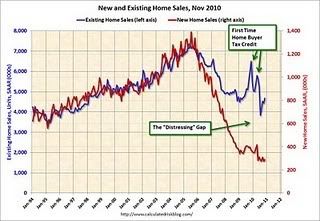Following the tax cut agreement, there was a little boomlet of economic happy talk. Retail sales are looking good, too. But even now reality is starting to sink in. Last week, in "Dean Baker takes a look at the stimulus that isn't there", we saw just how small the actual economic stimulus was, given that most of it was simply continuing existing law, along with other limiting factors. As I quoted him, Baker concluded:
In sum, the net stimulus for the economy from this package in 2011 will be in the range of $70bn, or about 0.5% of GDP. This is not likely to provide a substantial boost to growth.
But that was just the beginning. Increasingly, we're hearing renewed talk about the GOP agenda to slash domestic spending by $100 billion
--more than the paltry amount of the stimulus, completely canceling it out. And Senator Tom Coburn has the perfect rational ("Coburn: There Will Be 'Apocalyptic Pain' If We Don't Cut Spending"), telling Chris Wallace:
Chris, the history of Republics is they average 200 years of life, and they all fail in history over fiscal matters. They rot from within before they collapse."
Rot from within? Yes. Fiscal matters? Not so much. More like elite coups. Oligarchs and tyrants. Guys like Tom Coburn, in fact. "In order to save the republic, it was necessary to destroy it."
Even more serious is the proposed plan to push states into bankruptcy, in order to break public employee unions. The "incidental" financial wreckage could easily wipe out any sort of stimulative effect. D-Day had a new piece up at FDL yesterday discussing this.
"But all this is just political speculation!" I can just hear the cry. True enough. But what evidence is there that Democrats will do anything effective to fight back? Moreover, the housing news--from the sector where most of middle-class America's wealth resides--is not at all encouraging, as highlighted by two items from the BUILDER Pulse Newsletter from builderonline.com.
First, "Analysts in droves revise their home price forecasts downward for 2011" cites a WSJ report predicting home price declines in 2011:
Home prices won't show any year-over-year appreciation in 2011, according to the latest average of 110 forecasts from economists and housing analysts surveyed by MacroMarkets LLC.The survey shows that economists expect home prices to fall by 0.17% in 2011 as measured by the S&P/Case-Shiller index of home prices in 20 U.S. cities. The average forecast for 2010 calls for the Case-Shiller index to ultimately show that home prices ended the year down 1.13%.
Overall, economists expect home prices to rise by 7.2% over the five-year period ending in 2014. In May, that forecast called for a 12% rise in prices over the span.
Some 96 analysts surveyed made their forecasts public. Of those, 30 expect prices to fall next year, and another 30 are calling for annual home price appreciation of no more than 1%. The most bearish forecaster, A. Gary Shilling, president of A. Gary Shilling & Co., calls for prices to fall by 11% in 2011.
Second, "Distress widens gap between resales and new home sales" said:
Normally, or historically, a new home sale occurred for every six resales. But who remembers normal? The ratio now has drifted to one new for every 16 existing home sales, and that ratio is not likely to decrease anytime soon, as the number of distressed or foreclosure sales expected to hit the market in the next 18 months may range from 3 to 8 million.
in the process of highlighting an item from Calculated Risk:
Here is an update to a graph I've been posting for several years. This graph shows existing home sales (left axis) and new home sales (right axis) through November. This graph starts in 1994, but the relationship has been fairly steady back to the '60s. Then along came the housing bubble and bust, and the "distressing gap" appeared (due mostly to distressed sales).

[Click to Enlarge in New Window]
Initially the gap was caused by the flood of distressed sales. This kept existing home sales elevated, and depressed new home sales since builders couldn't compete with the low prices of all the foreclosed properties.Throughout the 1980s, Democrats were chastized for being too concerned about the poor. They needed to be more "business-friendly". But there never was any clear dividing line between the poor and the middle class, as the Great Recession finally brought home. Now Obama's "business-friendly" administration has left tens of millions in the middle class to sink on their own, and--most likely--the hopes of an entire nation with them.The two spikes in existing home sales were due primarily to the homebuyer tax credits (the initial credit in 2009, followed by the 2nd credit in 2010). There were also two smaller bumps for new home sales related to the tax credits.

No comments:
Post a Comment